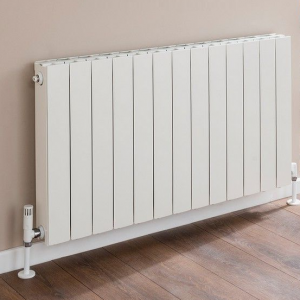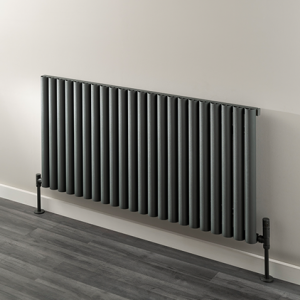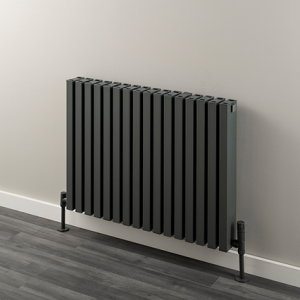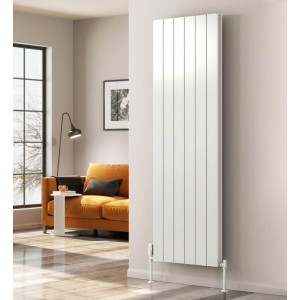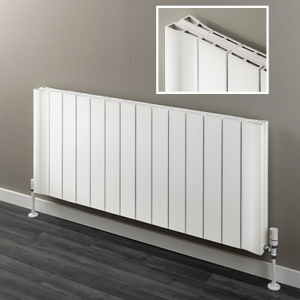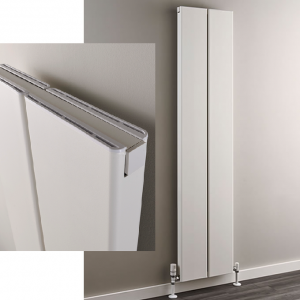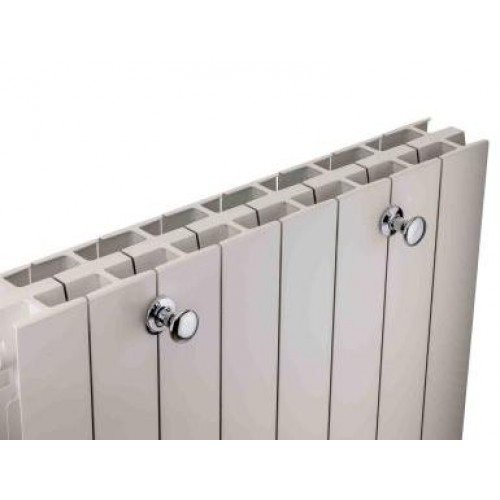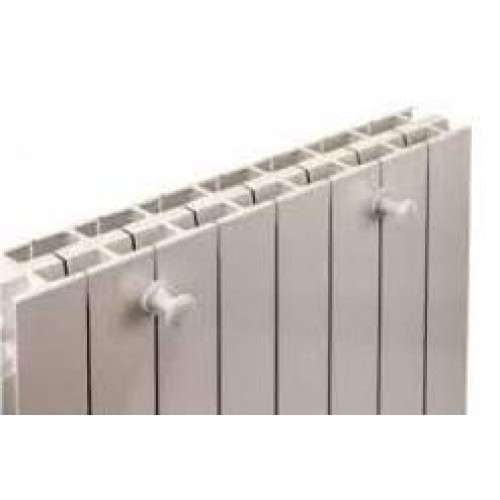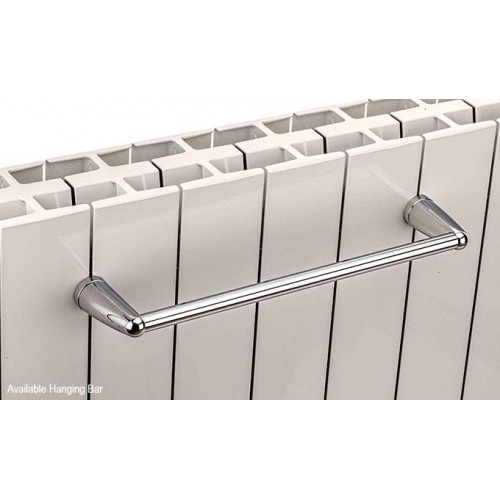Aluminium Radiators Products
Frequently Asked Questions
Why should I choose aluminium radiators over steel panel radiators?
The primary advantage is thermal responsiveness. Aluminium is a superconductor of heat compared to steel, heating up approximately 5 times faster. This allows your heating system to bring your room up to temperature rapidly when you need it.
Additionally, aluminium radiators are significantly lighter (often 50% lighter than steel), making them easier to handle and suitable for installation on internal stud walls where heavy steel units might require reinforcement.
Do aluminium radiators actually save money on energy bills?
Yes, when used correctly. Because they hold very little water (low water content) and the metal itself is light, they require less energy from the boiler to reach operating temperature.
The savings come from the reduction in "overshoot"—the radiator stops emitting heat almost immediately when the room thermostat is satisfied, preventing energy waste.
Are aluminium radiators compatible with Air Source Heat Pumps (ASHPs)?
Aluminium is widely considered the optimal material for heat pump systems. Heat pumps operate most efficiently at lower water temperatures (35°C–45°C).
Aluminium’s exceptional thermal conductivity ensures that even at these lower temperatures, the radiator can transfer heat effectively into the room. Furthermore, the extruded shapes often feature extensive fins that boost convection, compensating for the lower water temperature without needing to install overwhelmingly large radiators.
What is the difference between ""Cast"" and ""Extruded"" aluminium radiators?
- Extruded Aluminium: These are made by pushing heated aluminium through a die to create long, vertical shapes with complex internal channels (like the Oscar range). They are typically sleek, modern, and can be made very tall.
- Die-Cast Aluminium: These are made by pouring molten aluminium into a mould. They tend to have a more traditional sectional look and are often used for modular radiators where sections can be added or removed.
Both offer excellent thermal performance, so the choice is largely aesthetic.
Why are aluminium radiators more expensive than steel?
The cost difference reflects both the raw material price (aluminium is more expensive than mild steel) and the manufacturing complexity.
However, it is important to view this as a long-term investment. The energy savings over the radiator's lifespan, combined with the fact that aluminium does not rust externally like steel, can offer a better total return on investment.
How do I calculate the BTU output I need for an aluminium radiator?
You should use a standard BTU calculator based on your room’s dimensions, window size, and insulation levels. However, you must pay attention to the Delta T (Δt) value.
- Δt50 Standard rating for gas boilers.
- Δt30 Rating required for Heat Pumps or low-temp systems.
If you are using a heat pump, you will need a larger radiator surface area to achieve the same heat output. Budget Radiators provides specific outputs for these scenarios.
What does ""low water content"" mean for my boiler?
Low water content means the radiator contains only a fraction of the water found in a steel panel radiator.
- Benefit: Reduces the total mass the boiler needs to heat, allowing the system to heat up faster.
- Effect: The system cools down faster once off.
Modern modulating boilers work exceptionally well with this, as they can adjust their flame size quickly to match the rapid changes in return water temperature.
Can I use aluminium radiators on a Microbore pipe system?
Yes, aluminium radiators can work on microbore (8mm or 10mm) pipework.
In some cases, especially with larger radiators, 15mm pipework is recommended to ensure the radiator gets enough hot water to perform at its maximum efficiency.
What are ""pipe centers"" and how do I measure them for aluminium radiators?
Pipe centers refer to the distance between the two pipe inlets. For sectional aluminium radiators, this is usually the width of the radiator plus the width of the valves.
Crucially, many aluminium radiators have side connections, but some designer models have central or underneath connections.
Always check the specific technical drawing ("rough-in" sheet) before laying pipework, as aluminium radiators often have different tapping distances than standard steel panels.
Will my aluminium radiator make a clicking noise?
It is possible, but avoidable. The "clicking" is caused by the aluminium expanding as it heats up. Because aluminium expands more than steel, if it is hung on tight metal brackets without protection, it will "tick" as it rubs against them.
The Solution Always use the plastic inserts or buffers provided with the wall brackets. These allow the radiator to expand and contract silently.
Do I need special wall brackets?
Yes. Aluminium radiators should always be installed using the specific brackets supplied by the manufacturer.
Unlike steel radiators which often use generic "L" brackets, aluminium radiators (especially extruded ones) often require clamp-style brackets that fit into the rear channels of the extrusion. These are designed to handle the thermal movement of the metal.
Can I mix aluminium radiators with steel radiators in the same house?
Yes, this is very common (e.g., aluminium in the living room for aesthetics, steel in bedrooms). However, mixing metals increases the complexity of the water chemistry.
How do I bleed an aluminium radiator?
The process is the same as any radiator: turn off the heating, open the bleed valve with a key, and wait for water to squirt out.
Warning: Hydrogen Gas
If you release a gas that smells distinct or is flammable, this is hydrogen, not air. This indicates corrosion is occurring, and you should test your system water immediately.I've heard aluminium radiators corrode easily. Is this true?
Aluminium is susceptible to a specific type of electrochemical corrosion if the heating system water is not treated correctly. If the pH of the water goes above 8.5 or below 6.5, or if copper pipes are reacting with the aluminium, corrosion can occur.
However, this is entirely preventable. By flushing the system correctly upon installation and dosing it with a certified inhibitor (like Fernox F1 or Sentinel X100), aluminium radiators can last for decades.
What corrosion inhibitor must I use?
You must use an inhibitor that is pH buffered and certified for use with aluminium (often marked as NSF CIAS or BuildCert).
Avoid generic, cheap inhibitors that may be highly alkaline, as these can strip the protective oxide layer off the inside of the radiator.
Why does Budget Radiators offer a 10-year warranty when others offer 5?
Many competitors offer only a 5-year warranty on aluminium due to the risk of poor installation leading to corrosion.
Budget Radiators offers a 10-Year Guarantee on ranges like the Paxton and Oscar because we are confident in the quality of the alloy and the internal manufacturing processes. We believe that if installed correctly with the right inhibitor, our radiators are as durable as any steel product.
Can I paint my aluminium radiator if I change my decor?
It is generally not recommended.
Aluminium radiators are usually finished with a high-grade powder coat that is baked on for durability and heat transfer. Painting over this with standard radiator paint can look thick, may peel due to the high expansion rate of aluminium, and could reduce thermal output. It may also void your warranty.
If you must, use a specialist heat-resistant spray paint designed for automotive or radiator use.
Are aluminium radiators eco-friendly?
Yes, aluminium is one of the most sustainable materials for heating.
- Recycled Content: Many aluminium radiators are made from recycled metal. Recycling aluminium uses 95% less energy than producing new aluminium from ore.
- Recyclability: At the end of its life, an aluminium radiator is 100% recyclable. Unlike steel which rusts away, the aluminium can be melted down and reused infinitely.
- Efficiency: By helping your boiler or heat pump run more efficiently, they reduce your home's carbon footprint during their operational life.

